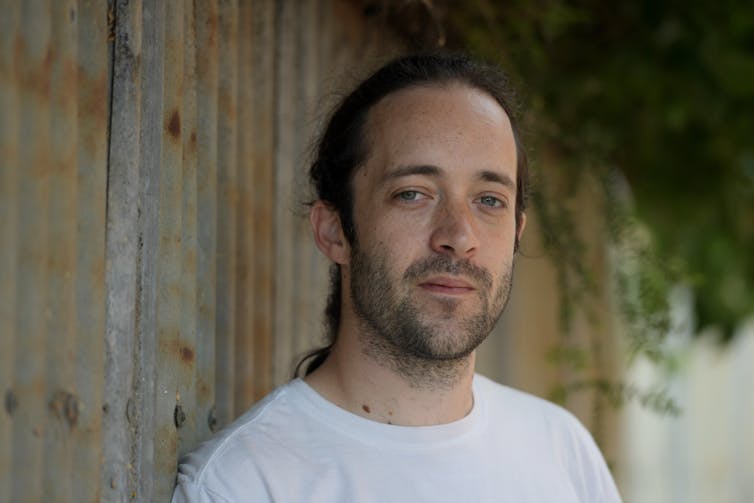No, you can't tap your hand to get on the train – where biohacktivists stand under the law
- Written by Bruce Baer Arnold, Assistant Professor, School of Law, University of Canberra
A brave step forward for cyborg rights? A media stunt? Or just indifference to contract law? Those are the questions raised by news that biohacker Meow-Ludo Disco Gamma Meow-Meow plans to take Transport for NSW (TfNSW) to court after it cancelled his digital travel card.
Last April, Mr Meow-Meow removed the chip from his card and had it surgically implanted under the skin of his hand. The dispute highlights tensions in how enthusiasts are adopting new technologies, ideologies of posthumanism and the ability of law to cope with disruption.
It’s also a reminder that just because you can do something doesn’t mean you should.
Read more: Hacking the body: the scientific counter-culture of the DIYbio movement
Parties to the dispute
Mr Meow-Meow is a biohacktivist. He has been a candidate in several elections for the Science Party. Prior to the current controversy he attracted attention for a DIY community DNA lab in Sydney – an expression of citizen science in which members of the public were encouraged to experiment with DNA.
 Mr Meow-Meow was the Science Party candidate running against Barnaby Joyce in the New England by-election in December.
AAP
Mr Meow-Meow was the Science Party candidate running against Barnaby Joyce in the New England by-election in December.
AAP
TfNSW runs public transport in the state, and many consumers rely on the TfNSW OPAL card. It’s a stored-value card that replaces traditional tickets and cash payment on buses, trains and ferries. The card is a piece of plastic with a RFID tag – a chip that is read wirelessly at points across the transport network.
That technology is not new – it’s being used in retail logistics and for access cards at universities. It is also the basis for “chipping” cats, dogs and other animals, so that owners can be reunited with their lost companions.
Mr Meow-Meow removed the chip from his Opal card for insertion under his skin. Rather than waving his card at a reader when travelling by train, he merely needed to wave his arm.
The law says ‘no’
Australian law recognises that people use prosthetics, and will increasingly do so. Many people wear spectacles. Some use hearing aids. Others have stents, pacemakers and various implants.
The law, however, does not recognise a “cyborg” and there are no “cyborg rights” in Australia. Adventures with digital implants – and playing with DNA in a community space – instead fall under law covering contracts, public health and other matters.
Use of the OPAL card is a matter of contract law. TfNSW owns the card. Consumers agree to abide by TfNSW’s terms and conditions. These are backed by the Passenger Transport Act, which outlines criminal sanctions for misuse. Those terms specify that the card cannot be modified, defaced or damaged.
The terms do not specifically refer to extraction of the chip from the card. They are silent about placing an extracted chip under your skin. There is similar legislation across Australia, and it is likely that some jurisdictions will fine-tune their law and contracts to reflect the current dispute.
Read more: Meet the biohackers letting technology get under their skin
Despite Mr Meow-Meow’s apparent hopes, a court is very likely to find that he has breached his contract and that TfNSW is fully entitled to end it. He will get headlines, but no satisfaction. Claims of discrimination would likely be unsuccessful.
The latest trend in body modification
Using subcutaneous chips to identify hospital patients, refugees, children, soldiers, prisoners, employees or night-clubbers is not a new idea. Technically there is no difference between the vet chipping your family cat and a practitioner chipping you.
There are anecdotal accounts of young IT people engaging in DIY chipping for convenience. It has become something of a fashion-statement in an environment where a piercing and tattoo is commonplace. Fortunately, it seems few people want to indulge in exotic body-modification such as self-trepanning – the practice of boring a hole into your skull.
Studies over the past decade have, however, expressed concern about ethical, legal and health issues – particularly in relation to DIY chipping. It’s not a reimbursable service under the national health system. There is a danger that chips could migrate from one part of the body to another. They could fail, and require removal. The enthusiast could end up with a scar or a nasty infection.
Responsive regulation
Much regulation of innovation is responsive: it occurs after things go wrong or are perceived as likely to go wrong in a big way.
But we need to think about principles regarding autonomy, harm and regulatory effectiveness. That is particularly the case with community DNA labs, due to concerns they raise about infections, antibiotic resistance and terrorism.
Read more: The next wearable technology could be your skin
Law does not prohibit Mr Meow-Meow from inserting a chip under his skin. He is an adult and is thus free to get a piercing, a tribal tattoo or modify his body in any way he chooses.
He cannot, however, appropriate a TfNSW chip without falling afoul of the law.
Should we specifically prohibit adults from engaging in self-chipping? There’s no need for specific prohibition. Medical practitioners should however refuse to assist DIY chipping. Public health and transport bodies should be encouraged when they refuse to endorse technological adventurism.
Authors: Bruce Baer Arnold, Assistant Professor, School of Law, University of Canberra





